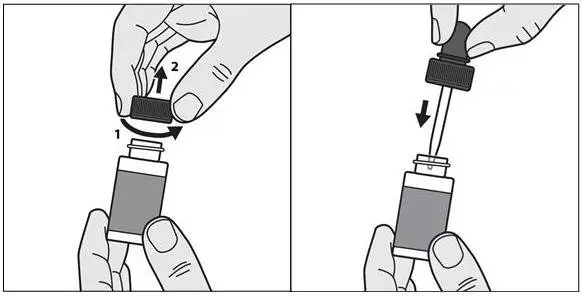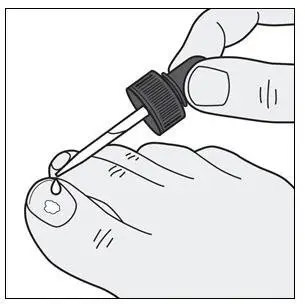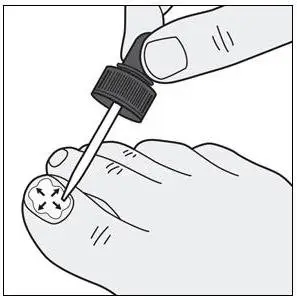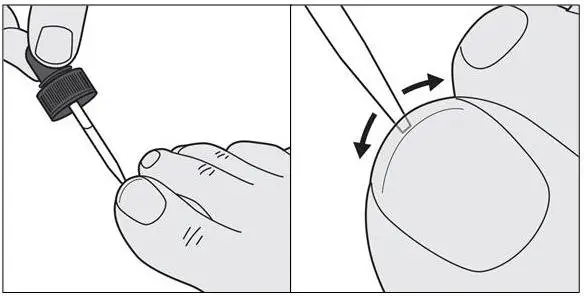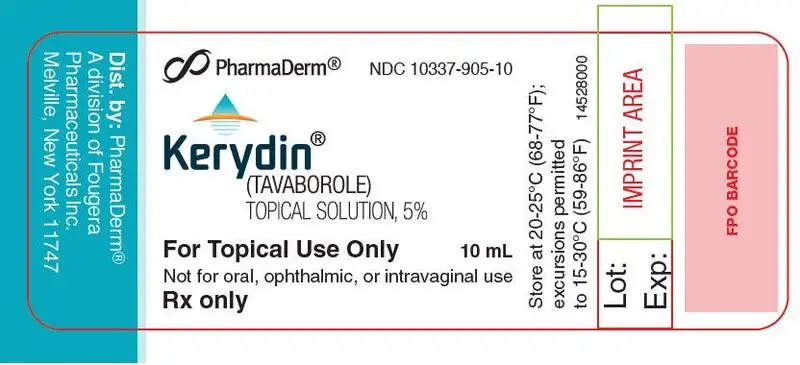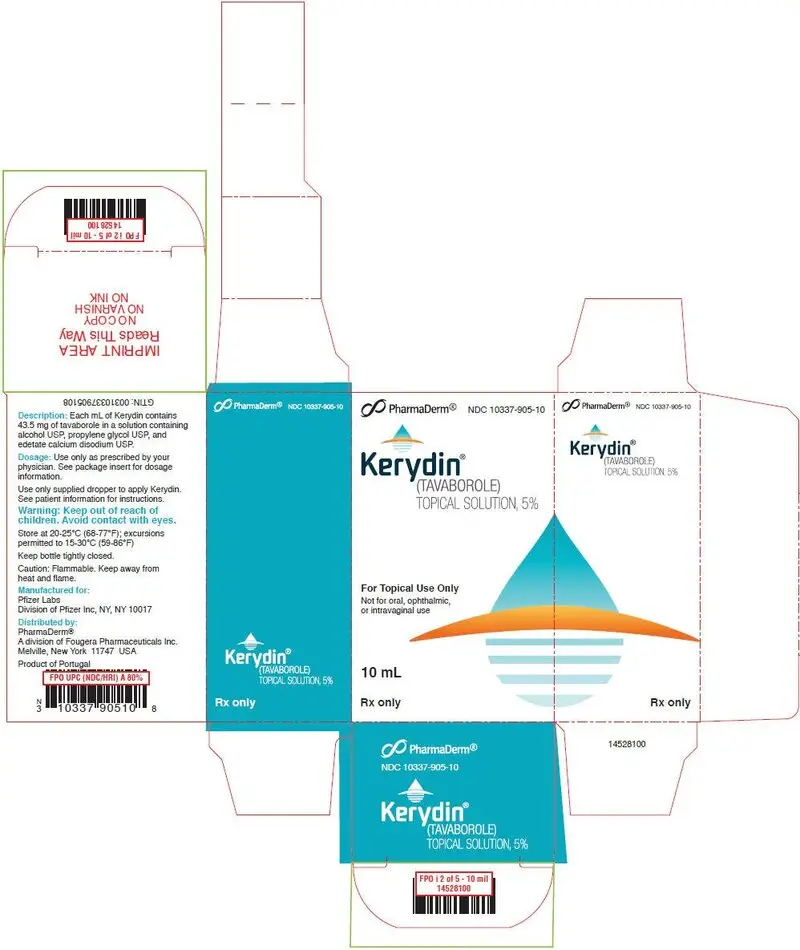Drug Detail:Kerydin (Tavaborole topical [ ta-va-bor-ole-top-ik-al ])
Drug Class: Topical antifungals
Highlights of Prescribing Information
KERYDIN® (tavaborole) topical solution
Initial U.S. Approval: 2014
Indications and Usage for Kerydin
KERYDIN is an oxaborole antifungal indicated for the topical treatment of onychomycosis of the toenails due to Trichophyton rubrum or Trichophyton mentagrophytes. (1)
Kerydin Dosage and Administration
- Apply KERYDIN to affected toenails once daily for 48 weeks. (2)
- KERYDIN should be applied to the entire toenail surface and under the tip of each toenail being treated. (2)
- For topical use only. (2)
- Not for oral, ophthalmic, or intravaginal use. (2)
Dosage Forms and Strengths
Solution, 5%. (3)
Contraindications
None. (4)
Adverse Reactions/Side Effects
Common adverse reactions occurring in ≥1% in subjects treated with KERYDIN included application site exfoliation, ingrown toenail, application site erythema, and application site dermatitis. (6.1)
To report SUSPECTED ADVERSE REACTIONS, contact Pfizer, Inc. at 1-800-438-1985 or FDA at 1-800-FDA-1088 or www.fda.gov/medwatch.
See 17 for PATIENT COUNSELING INFORMATION and FDA-approved patient labeling.
Revised: 8/2018
Related/similar drugs
terbinafine, itraconazole, Lamisil, griseofulvin, ciclopirox topical, JubliaFull Prescribing Information
1. Indications and Usage for Kerydin
KERYDIN (tavaborole) topical solution, 5% is an oxaborole antifungal indicated for the treatment of onychomycosis of the toenails due to Trichophyton rubrum or Trichophyton mentagrophytes.
2. Kerydin Dosage and Administration
Apply KERYDIN to affected toenails once daily for 48 weeks.
KERYDIN should be applied to the entire toenail surface and under the tip of each toenail being treated.
KERYDIN is for topical use only and not for oral, ophthalmic, or intravaginal use.
3. Dosage Forms and Strengths
KERYDIN topical solution, 5% is a clear, colorless alcohol-based solution. Each milliliter of solution contains 43.5 mg (5% w/w) of tavaborole.
6. Adverse Reactions/Side Effects
6.1 Clinical Trials Experience
Because clinical trials are conducted under widely varying conditions, adverse reaction rates observed in the clinical trials of a drug cannot be directly compared to rates in the clinical trials of another drug and may not reflect the rates observed in practice.
In two clinical trials, 791 subjects were treated with KERYDIN. The most commonly reported adverse reactions are listed below (Table 1).
| Preferred Term | KERYDIN N=791 n(%) | Vehicle N=395 n(%) |
|---|---|---|
| Application site exfoliation | 21 (2.7%) | 1 (0.3%) |
| Ingrown toenail | 20 (2.5%) | 1 (0.3%) |
| Application site erythema | 13 (1.6%) | 0 (0%) |
| Application site dermatitis | 10 (1.3%) | 0 (0%) |
6.2 Postmarketing Experience
The following adverse reactions have been identified during postmarketing use of KERYDIN. Because these reactions are reported voluntarily from a population of uncertain size, it is not always possible to reliably estimate their frequency or establish a causal relationship to drug product exposure:
Hypersensitivity; contact allergy
8. Use In Specific Populations
8.4 Pediatric Use
The safety and efficacy of KERYDIN were established in patients 6 years of age and older. Use of KERYDIN in these age groups is supported by evidence from adequate and well-controlled studies of KERYDIN in adults with additional data from an open-label pharmacokinetics study of tavaborole in subjects 12 years to less than 17 years old [see Clinical Pharmacology (12.3)].
8.5 Geriatric Use
In clinical trials of 791 subjects who were exposed to KERYDIN, 19% were 65 years of age and over, while 4% were 75 years of age and over. No overall differences in safety or effectiveness were observed between these subjects and younger subjects, but greater sensitivity of some older individuals cannot be ruled out.
11. Kerydin Description
KERYDIN (tavaborole) topical solution, 5% contains tavaborole, 5% (w/w) in a clear, colorless alcohol-based solution for topical use. The active ingredient, tavaborole, is an oxaborole antifungal with the chemical name of 5-fluoro-1,3-dihydro-1-hydroxy-2,1-benzoxaborole. The chemical formula is C7H6BFO2, the molecular weight is 151.93 and the structural formula is:
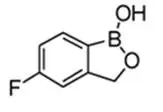
Tavaborole is a white to off-white powder. It is slightly soluble in water and freely soluble in ethanol and propylene glycol.
Each mL of KERYDIN contains 43.5 mg of tavaborole. Inactive ingredients include alcohol, edetate calcium disodium, and propylene glycol.
12. Kerydin - Clinical Pharmacology
12.2 Pharmacodynamics
At therapeutic doses, KERYDIN is not expected to prolong QTc to any clinically relevant extent.
12.3 Pharmacokinetics
Tavaborole undergoes extensive metabolism. Renal excretion is the major route of elimination of the metabolites.
In a clinical pharmacology trial of six healthy adult male volunteers who received a single topical application of 5% 14C-tavaborole solution, tavaborole conjugates and metabolites were shown to be excreted primarily in the urine.
The pharmacokinetics (PK) of tavaborole was investigated in 24 adult subjects with distal subungual onychomycosis involving at least 4 toenails (including at least 1 great toenail) following a single dose and a 2-week daily topical application of 200 μL of a 5% solution of tavaborole to all ten toenails and 2 mm of skin surrounding each toenail. Steady state was achieved after 14 days of dosing. After a single dose, the mean (± standard deviation) peak concentration (Cmax) of tavaborole was 3.5 ± 2.3 ng/mL (n=21 with measurable concentrations, range 0.618–10.2 ng/mL, LLOQ=0.5 ng/mL), and the mean AUClast ± SD was 44.4 ± 25.5 ng*hr/mL (n=21). After 2 weeks of daily dosing, the mean Cmax ± SD was 5.2 ± 3.5 ng/mL (n=24, range 1.5–12.8 ng/mL), and the mean AUCτ ± SD was 75.8 ± 44.5 ng*hr/mL.
In another study PK of tavaborole was investigated in 22 subjects aged 12 years to less than 17 years with distal subungual onychomycosis involving at least 4 toenails (including at least 1 great toenail with at least 20% involvement) following once daily application of 5% solution of tavaborole to all ten toenails and 2 mm of skin surrounding each toenail for 29 days. On Day 29, the mean ± SD Cmax was 5.9 ± 4.9 ng/mL (n=21 with measurable concentrations, range 1.0 –16.4 ng/mL, LLOQ=0.5 ng/mL), and the mean ± SD AUC0-24 was 76.0 ± 62.5 ng*hr/mL.
13. Nonclinical Toxicology
13.1 Carcinogenesis, Mutagenesis, Impairment of Fertility
In an oral carcinogenicity study in Sprague-Dawley rats, oral doses of 12.5, 25, and 50 mg/kg/day tavaborole were administered to rats once daily for 104 weeks. No drug related neoplastic findings were noted at oral doses up to 50 mg/kg/day tavaborole (14 times the MRHD based on AUC comparisons).
In a dermal carcinogenicity study in CD-1 mice, topical doses of 5%, 10%, and 15% tavaborole solution were administered to mice once daily for 104 weeks. No drug related neoplastic findings were noted at topical doses up to 15% tavaborole solution (89 times the MRHD based on AUC comparisons).
Tavaborole revealed no evidence of mutagenic or clastogenic potential based on the results of two in vitro genotoxicity tests (Ames assay and Human lymphocyte chromosomal aberration assay) and one in vivo genotoxicity test (rat micronucleus assay).
No effects on fertility were observed in male and female rats that were administered oral doses up to 300 mg/kg/day tavaborole (107 times the MRHD based on AUC comparisons) prior to and during early pregnancy.
14. Clinical Studies
The efficacy and safety of KERYDIN was evaluated in two multicenter, double-blind, randomized, vehicle-controlled trials. KERYDIN or vehicle was applied once daily for 48 weeks in subjects with 20% to 60% clinical involvement of the target toenail, without dermatophytomas or lunula (matrix) involvement.
A total of 1194 subjects (795 KERYDIN, 399 Vehicle) 18 to 88 years of age, 82% male, 84% white, participated in these two trials. Efficacy assessments were made at 52 weeks following a 48-week treatment period.
The Complete Cure efficacy endpoint included negative mycology (negative KOH wet mount and negative fungal culture) and Completely Clear Nail (no clinical evidence of onychomycosis as evidenced by a normal toenail plate, no onycholysis, and no subungual hyperkeratosis). Efficacy results from the two trials are summarized in Table 2.
| Efficacy Variable | Trial 1 | Trial 2 | ||
|---|---|---|---|---|
| KERYDIN N=399 n(%) | Vehicle N=194 n(%) | KERYDIN N=396 n(%) | Vehicle N=205 n(%) |
|
|
||||
| Complete Cure* | 26 (6.5%) | 1 (0.5%) | 36 (9.1%) | 3 (1.5%) |
| Complete or Almost Complete Cure† | 61 (15.3%) | 3 (1.5%) | 71 (17.9%) | 8 (3.9%) |
| Mycologic Cure‡ | 124 (31.1%) | 14 (7.2%) | 142 (35.9%) | 25 (12.2%) |
16. How is Kerydin supplied
16.1 How Supplied
KERYDIN (tavaborole) topical solution, 5% is a clear, colorless solution supplied in an amber glass bottle with a screw cap. At initial use, the screw cap is replaced with the dropper assembly.
KERYDIN (tavaborole) topical solution, 5% is supplied in the following presentations:
NDC 10337-905-10: One bottle containing 10 mL of solution with one glass pointed-tip dropper.
NDC 10337-905-44: One bottle containing 4 mL of solution with one glass pointed-tip dropper.
16.2 Storage and Handling
Store at 20–25°C (68–77°F); excursions permitted to 15–30°C (59–86°F) [see USP Controlled Room Temperature].
CAUTION: Flammable. Keep away from heat and flame.
Discard product within 3 months after insertion of the dropper.
Keep bottle tightly closed. Keep out of reach of children.
17. Patient Counseling Information
See FDA-approved patient labeling (Patient Information and Instructions for Use)
The patient should be told the following:
- The impact of nail polish or other cosmetic nail products on the efficacy of KERYDIN has not been evaluated.
- Inform a health care professional if the area of application shows signs of persistent irritation (for example, redness, itching, swelling).
- Product is flammable. Avoid use near heat or open flame.
| PATIENT INFORMATION KERYDIN® (ker' i din) (tavaborole) topical solution, 5% |
|
|---|---|
| This Patient Information has been approved by the U.S. Food and Drug Administration. | Revised August/2018 |
| Important information: KERYDIN is for use on toenails only. Do not use KERYDIN in your mouth, eyes, or vagina. | |
| What is KERYDIN?
KERYDIN is a prescription medicine used to treat fungal infections of the toenails. It is not known if KERYDIN is safe and effective in children less than 6 years age. |
|
|
Before using KERYDIN, tell your healthcare provider about all of your medical conditions, including if you:
|
|
| How should I use KERYDIN?
See the "Instructions for Use" at the end of this Patient Information for detailed information about the right way to use KERYDIN.
|
|
What should I avoid while using KERYDIN?
|
|
| What are the possible side effects of KERYDIN?
The most common side effects of KERYDIN include: skin peeling, ingrown toenail, redness, itching, and swelling. KERYDIN may cause irritation at or near the application site. Tell your healthcare provider if you develop irritation at the application site that does not go away. These are not all of the possible side effects of KERYDIN. Call your doctor for medical advice about side effects. You may report side effects to FDA at 1-800-FDA-1088. |
|
How should I store KERYDIN?
|
|
| Keep KERYDIN and all medicines out of the reach of children. | |
| General information about the safe and effective use of KERYDIN
Medicines are sometimes prescribed for purposes other than those listed in a Patient Information leaflet. Do not use KERYDIN for a condition for which it was not prescribed. Do not give KERYDIN to other people, even if they have the same symptoms that you have. It may harm them. You can ask your pharmacist or healthcare provider for information about KERYDIN that is written for health professionals. |
|
| What are the ingredients in KERYDIN?
Active ingredient: tavaborole Inactive ingredients: alcohol, edetate calcium disodium and propylene glycol Manufactured for: Pfizer Labs, Division of Pfizer Inc, NY, NY 10017 Distributed by: PharmaDerm®, a division of Fougera Pharmaceuticals, Inc., Melville, New York 11747 USA For more information, call PharmaDerm®, a division of Fougera Pharmaceuticals, Inc., at 1-800-645-9833. LAB-1203-2.0 |
|
Instructions for Use
KERYDIN® (ker' i din)
(tavaborole) topical solution, 5%
| Important information: KERYDIN is for use on toenails only. Do not use KERYDIN in your mouth, eyes, or vagina. |
Read the Instructions for Use that comes with KERYDIN before you start using it. Talk to your healthcare provider if you have any questions.
How to apply KERYDIN:
Your toenails should be clean and dry before you apply KERYDIN.
| Step 1: | Before you apply KERYDIN to your affected toenail for the first time, remove the cap from the KERYDIN bottle. (See Figure A) Throw away the cap. | |
| Step 2: | Remove the wrapping from the dropper that comes with KERYDIN. Insert the dropper into the KERYDIN bottle. (See Figure B) | |
| Figure A | Figure B | |
| Only apply KERYDIN using the provided dropper. Do not use the dropper for any other purpose. | ||
| Step 3: | With the dropper inserted into the KERYDIN, squeeze the bulb and then release the bulb to draw KERYDIN into the dropper. | |
| Step 4: | Remove the dropper from the bottle and hold the dropper tip over your affected toenail. | |
| Step 5: | Slowly squeeze the bulb to apply KERYDIN to your toenail. Apply enough solution to completely cover your toenail. You may need to use more than one drop. (See Figure C) Figure C | |
| Step 6: | Use the dropper tip to gently spread KERYDIN to cover the entire toenail up to the edges of the toenail. (See Figure D) Figure D | |
| Step 7: | In addition to the top of the toenail, also apply KERYDIN under the tip of the toenail. Use the dropper tip to gently spread KERYDIN under the entire tip of the toenail. (See Figures E and F) | |
| Figure E | Figure F | |
| Step 8: | Repeat Steps 3 to 7 to apply KERYDIN to each affected toenail. | |
| Step 9: | Let the KERYDIN dry completely. This may take a couple of minutes. Avoid getting KERYDIN on skin that is not surrounding the treated toenail(s). If KERYDIN comes in contact with surrounding skin, use a tissue to wipe any excess solution from the surrounding skin. Do not wipe KERYDIN off of your toenails. |
|
| Step 10: | After applying KERYDIN to your toenails, insert the dropper back into the bottle and screw it on tightly. | |
| Step 11: | Wash your hands with soap and water after applying KERYDIN. | |
This Patient Information and Instructions for Use has been approved by the U.S. Food and Drug Administration.
Manufactured for: Pfizer Labs, Division of Pfizer Inc, NY, NY 10017
Distributed by: PharmaDerm®, a division of Fougera Pharmaceuticals, Inc., Melville, New York 11747 USA
LAB-1204-2.0
Revised: 08/2018
| KERYDIN
tavaborole solution |
||||||||||||||||||||||||||||||
|
||||||||||||||||||||||||||||||
|
||||||||||||||||||||||||||||||
|
||||||||||||||||||||||||||||||
|
||||||||||||||||||||||||||||||
|
||||||||||||||||||||||||||||||
| Labeler - PharmaDerm, A division of Fougera Pharmaceuticals Inc. (043838424) |
| Registrant - Pfizer Inc (113480771) |




